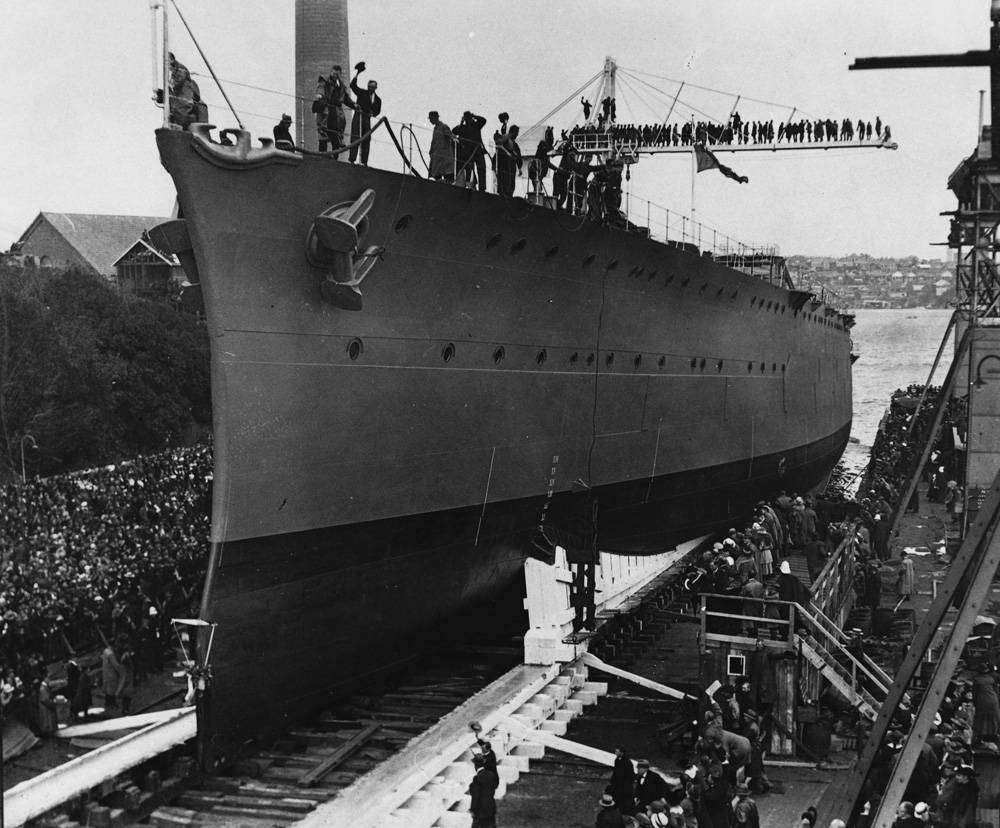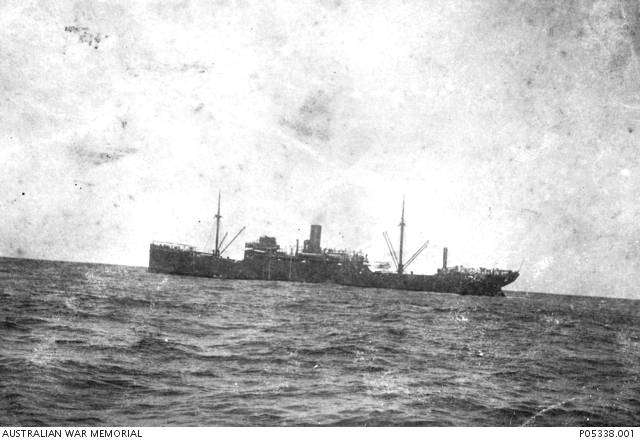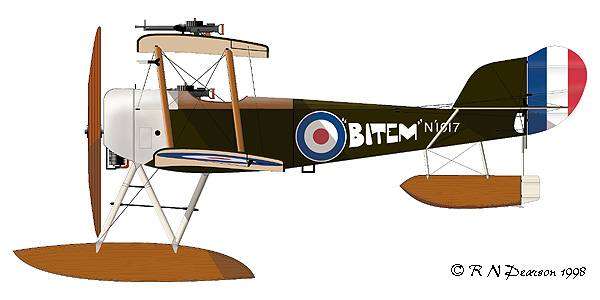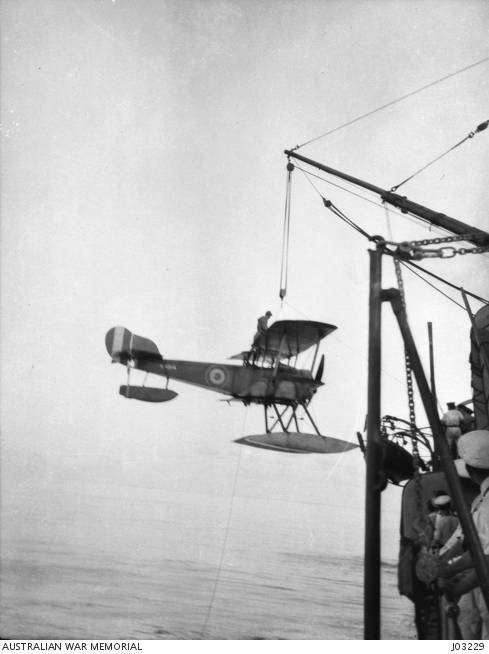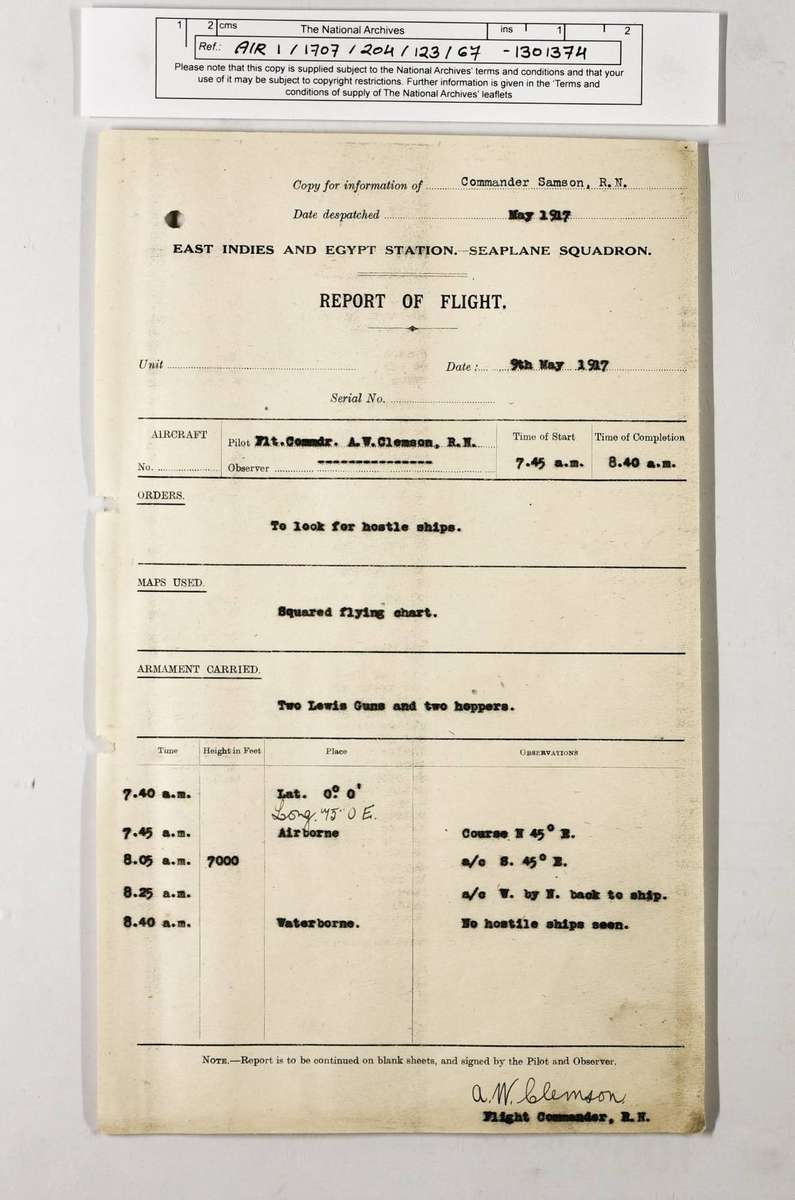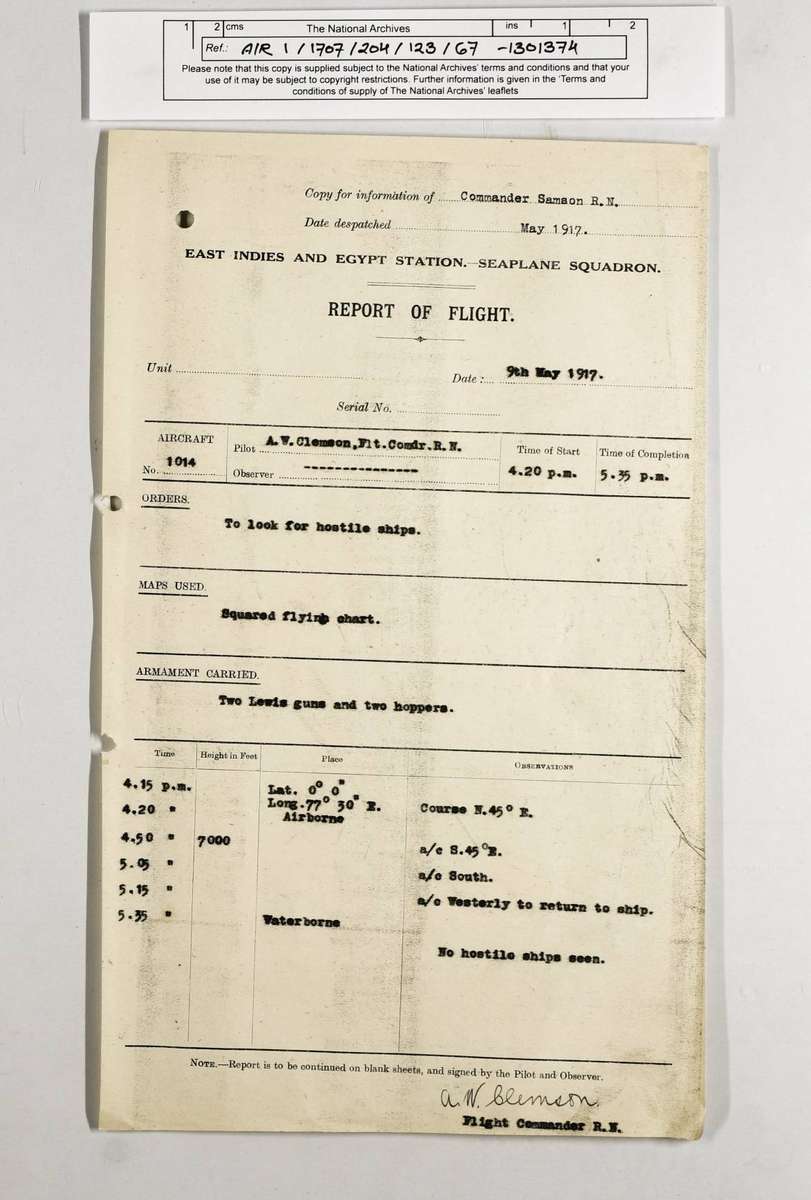HMAS Brisbane (1) and the Sopwith Baby
Kim Dunstan
The well documented exploits of her sister ships HMAS Sydney and Melbourne [and battle cruiser HMAS Australia (1)] operating with the Royal Navy in the North Sea – which centred on the development of platforms to launch Sopwith aircraft against the Zeppelins in 1918 – tends to overshadow the fact that early in 1917 HMAS Brisbane (1) was the first RAN ship to embark and operate an aircraft for scouting and reconnaissance work – to search for a German merchant raider at large in the Indian Ocean. Although it was a short operation it is particularly significant because it marks the very beginning of Naval Aviation operations at sea in the Royal Australian Navy.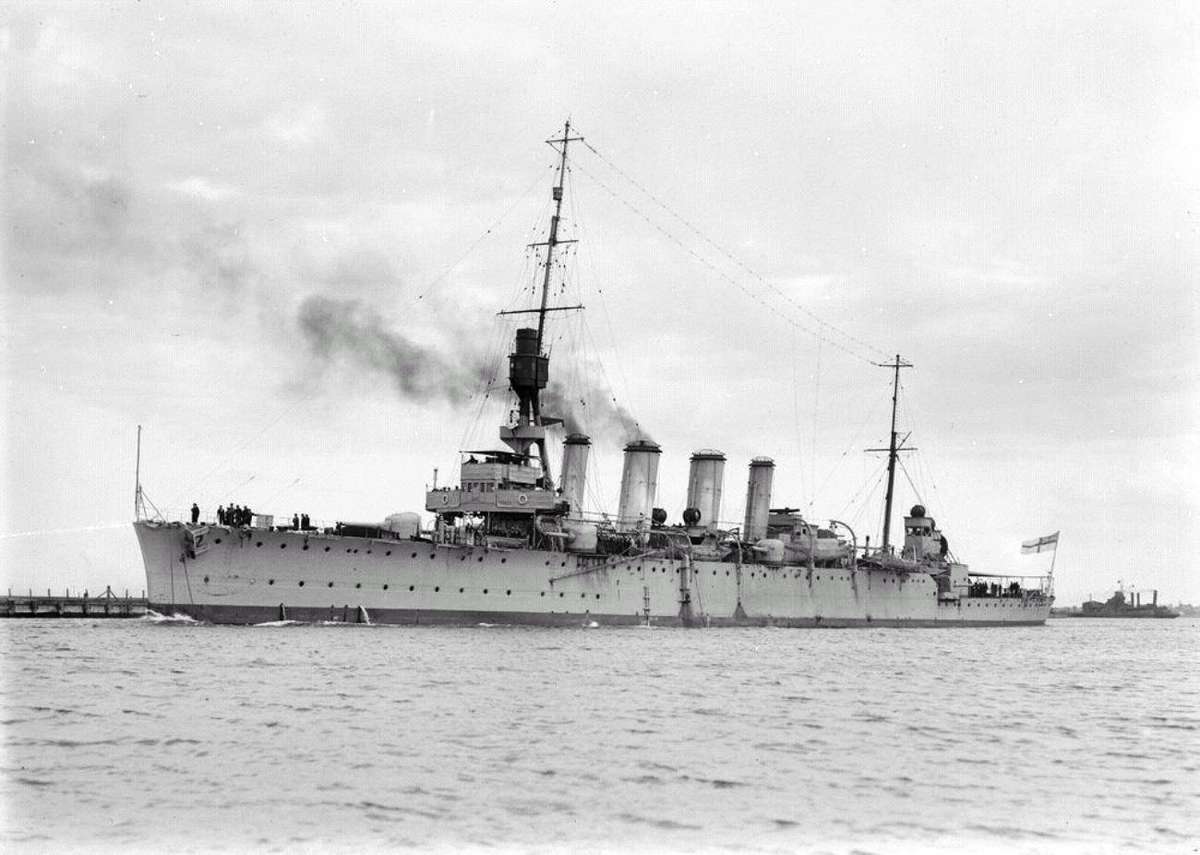
Above: HMAS Brisbane (1)
HMAS Brisbane (1) was a ‘Chatham’ design Town Class light-cruiser, built at Cockatoo Island, Sydney, and Commissioned in October 1916. She was 5,400 tons, 450 feet long, with a speed of 25 knots, and had 8 x 6 inch guns, plus other smaller calibre guns; together with 2 x 21 inch submerged torpedo tubes, and a crew of 485.
HMAS Brisbane being launched in Sydney 30 Sep 1915
On 12 December 1916, under the command of Captain Claude L. Cumberlege RN, HMAS Brisbane departed Sydney for the Mediterranean, arriving at Malta on 4 February 1917. Here Brisbane was fitted with new war equipment unavailable in Australia at the time. After a brief period in the Mediterranean Brisbane was despatched to the East Indies Station, based at Colombo, to assist in the hunt for an unnamed German raider that had laid mines off the coast of South Africa and was now believed to be at loose in the Indian Ocean.
SMS Wolf: A converted freighter with the appearance of a merchant vessel, but with significant armament.
r
The German raider was SMS Wolf, a converted freighter of 11,200 tons with a cruising speed of 11 knots, was fitted-out as an auxiliary cruiser of the Imperial German Navy. Wolf’s carefully concealed weapons included 7x15cm (5.9 in) guns, three 5.2cm (2 in) guns and other small weapons as well as four 500mm (20 in) torpedo tubes; Wolf also carried 458 mines. The ship’s bunkers held an astonishing 8,000 tons of coal giving a range of over 32,000 nm. A fake funnel and masts could be quickly raised or lowered to change her appearance. Commander Karl Nerger was in charge of Wolf – capturing and sinking some 110,000 tons of shipping.
Above: Wolf’s FF33e Floatplane. Technically inferior to the Sopwith Baby, it nevertheless contributed significantly to the success of Wolf’s mission.
SMS Wolf also carried a Friedrichshafen FF.33e two-seater floatplane to scout for shipping targets. Called Wolfchen (wolf cub) it was responsible for much of Wolf’s success. The small biplane had a 150 hp in-line Benz Bz111 engine, giving a speed of 110 km/h (60 knots, 68 mph); it could carry 8 x 12 kg bombs and had a radio transmitter. On deck it was positioned next to the aft crane which hoisted or lowered it onto the water – when not in use the wings were removed and stowed separately.
Shortly after Brisbane arrived at Colombo on 4th May 1917, a Sopwith Baby scout-bomber floatplane was transferred from the seaplane carrier HMS Raven (11) to Brisbane, to assist in the search for the German raider. The Sopwith Baby, serial number N1014, was a single seat biplane, using a 110 hp Clerget rotary engine; with a top speed of 162 km/h (100 mph, 87 knots) and a duration of 2.25 hours. It had Lewis guns mounted on the top wing and could carry 2 x 65lb bombs. The Sopwith Baby was stowed aft of Brisbane’s rear funnel and was hoisted to and from the water by the ship’s derrick.
Over the period 5th and 6th May 1917, Flight Officer Alfred W Clemson RNAS and four aircraft mechanics, together with stores and spares were transferred from HMS Raven (11) to Brisbane. The ship then proceeded to patrol the Indian Ocean for several weeks in search of the raider. During this period the Sopwith Baby was used extensively, conducting wide-area searches for the elusive Wolf. However, the search was in vain as by this time Wolf was making its way across the Southern Ocean. However, Captain Cumberlege was greatly impressed by the reach and versatility of the Sopwith Baby.
After scouring the seas around the southern part of India and Ceylon (Sri Lanka), where Wolf had mined shipping lanes, Brisbane returned to Colombo where the Sopwith Baby was returned to HMS Raven (11). While the search was fruitless the experience with the Sopwith Baby proved to be valuable – and its loss much regretted. In June 1917 Brisbane was detached from the East Indies Squadron and sent to patrol the Western Australian coast. Meanwhile, the presence of Wolf in the Pacific was evident when two ships hit mines near New Zealand; then in July 1917 SS Cumberland struck a mine near Gabo Island. Wolf laid 22 mines in Bass Strait before sailing north via the Solomon Islands, then west towards Singapore.
The Sopwith Baby
The Sopwith Baby was a British single-seat tractor seaplane used by the Royal Naval Air Service (RNAS) from 1915.
The Baby was a development of the two-seat Sopwith Schneider. Although the Schneider had won the Schneider trophy in 1914, the RNAS did not place a formal order until January 1915. Sopwith’s initial production version of the Baby differed little from the Schneider Trophy winner.
The Baby utilized a wooden structure with fabric covering. A Lewis Gun was fitted, either above the fuselage firing through the propeller arc without the benefit of synchronization, or over the top wing, firing above it. To meet the more demanding conditions of 1916–18, Further modifications were made on aircraft built by Blackburn Aircraft at Leeds, United Kingdom.
The Baby was used as a shipborne reconnaissance and bomber aircraft operating from seaplane carriers and cruisers, as well as naval trawlers and minelayers.
A major role of the Baby was to intercept German Zeppelin raids as far from Britain as possible, along with tracking German naval movements.
Babies saw service with the United States, France, Chile, Greece and Norway. In Norway additional Babies were built as replacements, with some seeing service until 1930. Two of the 10 Sopwith Baby floatplanes that were acquired by the Royal Norwegian Navy Air Service were brought to Svalbard in the summer of 1928 to participate in the search for the lost Norwegian polar explorer Roald Amundsen, but were not used for the search.
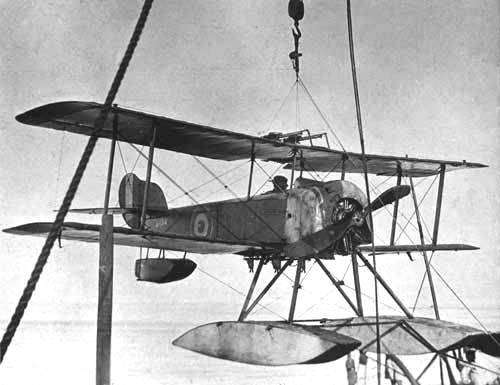 Only one Sopwith Baby was ever embarked in an RAN vessel; in HMAS Brisbane, as described in this article. Examination of the Signal Log of HMAS Brisbane and the Ship’s Log of HMS Raven II (which loaned the aircraft) reveal that stores and spares were transferred to Brisbane on 05 May 1917 and the aircraft was first hoisted aboard on 09 May 1917 and returned to its mother ship on 15 May. HMS Raven II then sailed for in company with Brisbane on 17 May 1917.
Only one Sopwith Baby was ever embarked in an RAN vessel; in HMAS Brisbane, as described in this article. Examination of the Signal Log of HMAS Brisbane and the Ship’s Log of HMS Raven II (which loaned the aircraft) reveal that stores and spares were transferred to Brisbane on 05 May 1917 and the aircraft was first hoisted aboard on 09 May 1917 and returned to its mother ship on 15 May. HMS Raven II then sailed for in company with Brisbane on 17 May 1917.
Despite this short period of active service the Baby proved its worth and contributed to the eventual acceptance of organic air support at sea. Noting that dedicated air stores were embarked on 5 May 1917, this date is flagged as the moment that dedicated organic aviation began aboard an RAN vessel.
Sopwith Baby statistics:
- Crew: one
- Length: 23 ft 0 in (7.01 m)
- Wingspan: 25 ft 8 in (7.82 m)
- Height: 10 ft 0 in (3.05 m)
- Wing area: 240 ft² (22.30 m²)
- Empty weight: 1,226 lb (557 kg)
- Loaded weight: 1,715 lb (779 kg)
- Powerplant: 1 × Clerget rotary engine, driving a two blade wooden propeller, 110 hp (82 kW)
Performance
- Maximum speed: 87 knots (100 mph, 162 km/h) at sea level
- Service ceiling: 10,000 ft (3,050 m)
- Rate of climb: 285 ft/min (1.45 m/s)
- Endurance: 2.25 hrs
Armament
- 1 × Lewis gun
- 2 × 65 lb (28 kg) bombs
In September 1917 Brisbane was ordered to the South Pacific, due to the presence of yet another German raider SMS Seeadler, an armed sailing ship that was causing havoc. However by then Seeadler was already a wreck having struck a reef in French Polynesia. So, from October 1917 to January 1918, Brisbane patrolled the Western Pacific, visiting the Solomon Islands, Nauru, Ocean Island, Tarawa and Fiji.
It was during this period that the loss of the Sopwith Baby was keenly felt by Captain Cumberlege. He said: ‘The ideal method of watching this part of the world would be by seaplane; the smallest type could always find smooth water to operate from.’ As seaplanes were not available several schooners with wireless apparatus helped, but they were no match for a seaplane. By now Cumberlege was an aviation enthusiast.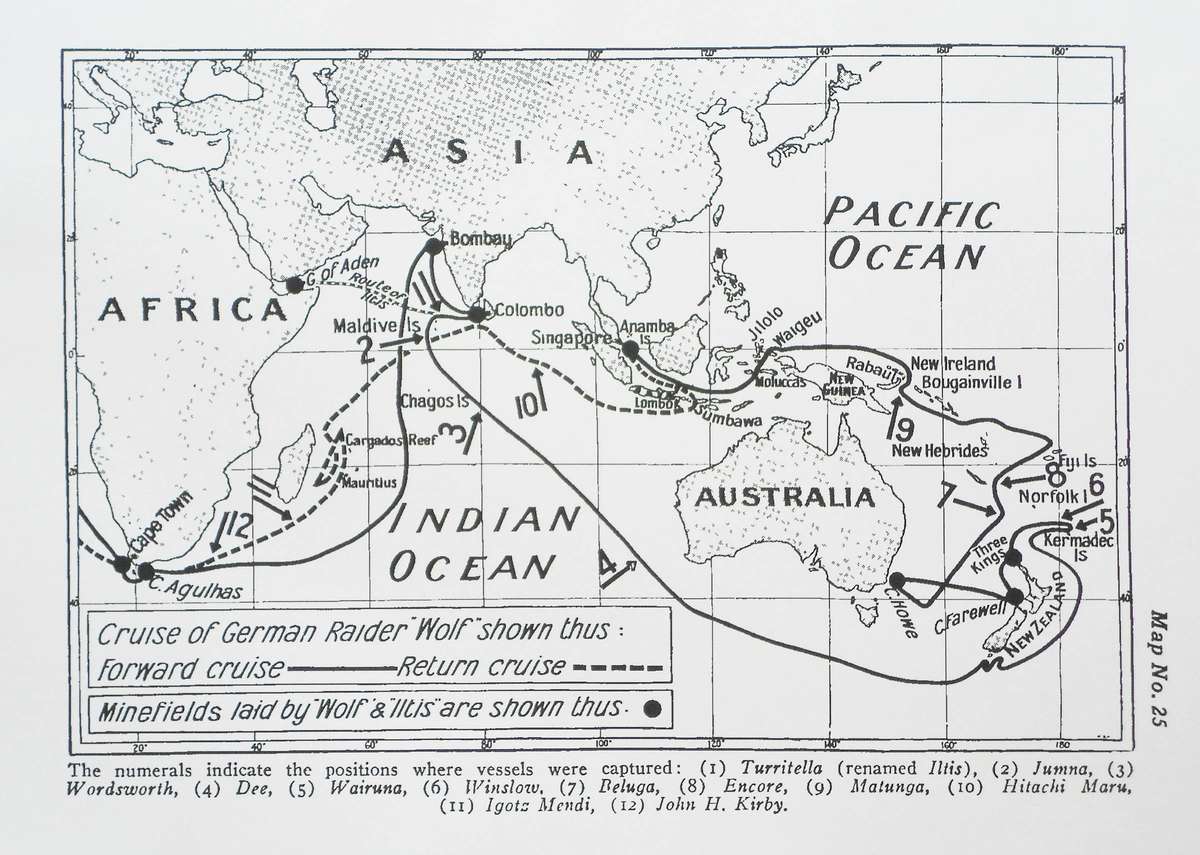
From February to October 1918 Brisbane patrolled Australian waters. Captain Cumberlege repeatedly advocated the use of seaplanes in the defence of Australia. In June 1918 while patrolling northern Queensland he searched Torres Strait looking for suitable sites for aeroplane operations, and found two admirable places. Cumberlege said ‘Torres Strait area could be swept by aeroplanes with the greatest facility and that climatic conditions were most favourable, and any ships passing through at night would be soon spotted from the air during daytime’.
Clearly impressed by his experience in the Indian Ocean with the Sopwith Baby seaplane, Captain Cumberlege strongly recommended their use to the Australian Naval Board, who responded favourably and asked the Admiralty to quote a price for four Sopwith Baby aircraft or similar. The reply from the Admiralty included the comment that “the use of small seaplanes from Cruisers is not now recommended. No Sopwith Baby Seaplanes are available and the type is dying out” [that is production had ceased]. A price of £1,734.15.0 complete was quoted with spares for upkeep for five machines £390. At the time seaplanes were being replaced on HM capital ships and cruisers by wheeled land planes and experiments were being conducted using aircraft launching ramps built on or over the ships’ guns, enabling Sopwith Camel fighters to take-off to combat the Zeppelin and German aircraft threat to RN ships in the North Sea. With the development of newer types of seaplanes, including the famous Supermarine Seagull V and Walrus capable of being catapult launched, seaplanes continued to be used on cruisers into WW2. The important point here is that HMAS Brisbane (1) and the Sopwith Baby now hold an important position in the history of RAN aviation.
Epilogue
One of the ships the FF.33e helped to capture was the Burns-Philip steamer ‘Matunga’ sailing from Sydney to Rabaul (9 on the map). Wolf intercepted a radio message from Matunga saying she would reach Rabaul the next day. The FF.33e spotted the ship and Wolf captured her the next day (6 August 1917) just hours from Rabaul. Amongst her passengers were 16 members of the Australian military garrison returning from leave, including five senior officers. She also carried 500 tons of coal for HMAS Una, and another 1,000 tons for the administration and inter-island steamers, plus a large cargo of provisions. Wolf escorted her prize to a point north of New Guinea where she was looted and sunk, with the passengers eventually being transported to Germany.
In February 1918 Wolf returned to Kiel, Germany, having operated without support vessels or port visits; relying entirely on provisions and coal from the ships it captured. During her 15 month voyage Wolf sank 12 ships, retaining one (the Spanish freighter Igotz Mendi) as a prize. A further 13 ships were sunk by mines laid by Wolf. At Kiel 467 prisoners were landed from captured ships. On arrival the FF.33e flew triumphantly over Kiel harbour.
Below: Flight Reports from Flt Cdr Clemson, the pilot of the Sopwith Baby, while he operated from HMAS Brisbane. Numbering from left: [1 & 2] Reports on the AM and PM flights on 9 May 1917. Similar reports were filed for 10 & 11 May. (TNA Kew) [3] Report from Captain Cumberlege RN, CO of HMAS Brisbane, to Navy Office highlighting the value of the Sopwith Baby for searches. A revolution in those pre-radar days. (NAA, Melbourne).
Brisbane reached Colombo on 4 May and sailed two days later on her first escort operation: heading for the Seychelles with a convoy of three transports. After two days she handed over her charges to Gloucester, then began a patrol in the vicinity of the Maldives. Wemyss had directed Raven II to disembark at Colombo two Sopwith Baby seaplanes with the necessary stores and personnel, and Brisbane became the first of his cruisers to employ the aircraft.
Cumberlege arranged for a temporary platform to be erected just before the mainmast and abaft the break of the boat deck. From there it required only five minutes to hoist out the plane, and about the same time to recover it. The pilot, Flight Commander Alfred Clemson, was an experienced aviator who had won the DSC in February for carrying out a dangerous reconnaissance over Damascus. He and Cumberlege settled on a pattern of twice daily flights,conducted for an hour alter dawn and an hour belore dusk, using a triangular search pattern with 20 minute legs. The coverage allowed Cumberlege to steam at slow speed overnight in reasonable confidence that nothing would escape Brisbane’s attention. With Wolf on the way to the Kermadecs, the searches found nothing of significance, but Cumberlege had been impressed by the ease of manipulation and the great increase in patrol efficiency the seaplane provided.
In All Respects Ready. David Stevens p278
References:
History of Australia in the War of 1914-18, Vol IX
ADF Serials
Wikipedia
Mac’s Ahoy
National Archives Australia, Melbourne
The National Archives, Kew, London

